Charles Sturt University: ITC571 Annotated Bibliography Report
VerifiedAdded on 2020/05/16
|22
|6864
|113
Report
AI Summary
This annotated bibliography examines various research papers related to employee management systems, focusing on the application of emerging technologies and innovations. The bibliography includes studies on automated recruitment, utilizing machine learning algorithms for candidate evaluation and ranking, and explores the benefits of Human Resource Information Systems (HRIS) in strategic human resource management. Several papers address the use of data mining, personality mining, and recommendation systems in e-recruitment, aiming to eliminate bias and improve the efficiency of the recruitment process. The bibliography also covers topics such as wireless attendance management using iris recognition, automated analysis of job interview performance through facial expression analysis, and stochastic programming for employee scheduling in retail environments. Furthermore, it delves into the design and implementation of automated personnel recruitment systems, the effectiveness of electronic selection systems, and models for assessing user satisfaction with employee portals. The studies highlight the potential of these technologies to streamline employee management, enhance decision-making, and improve overall organizational efficiency.
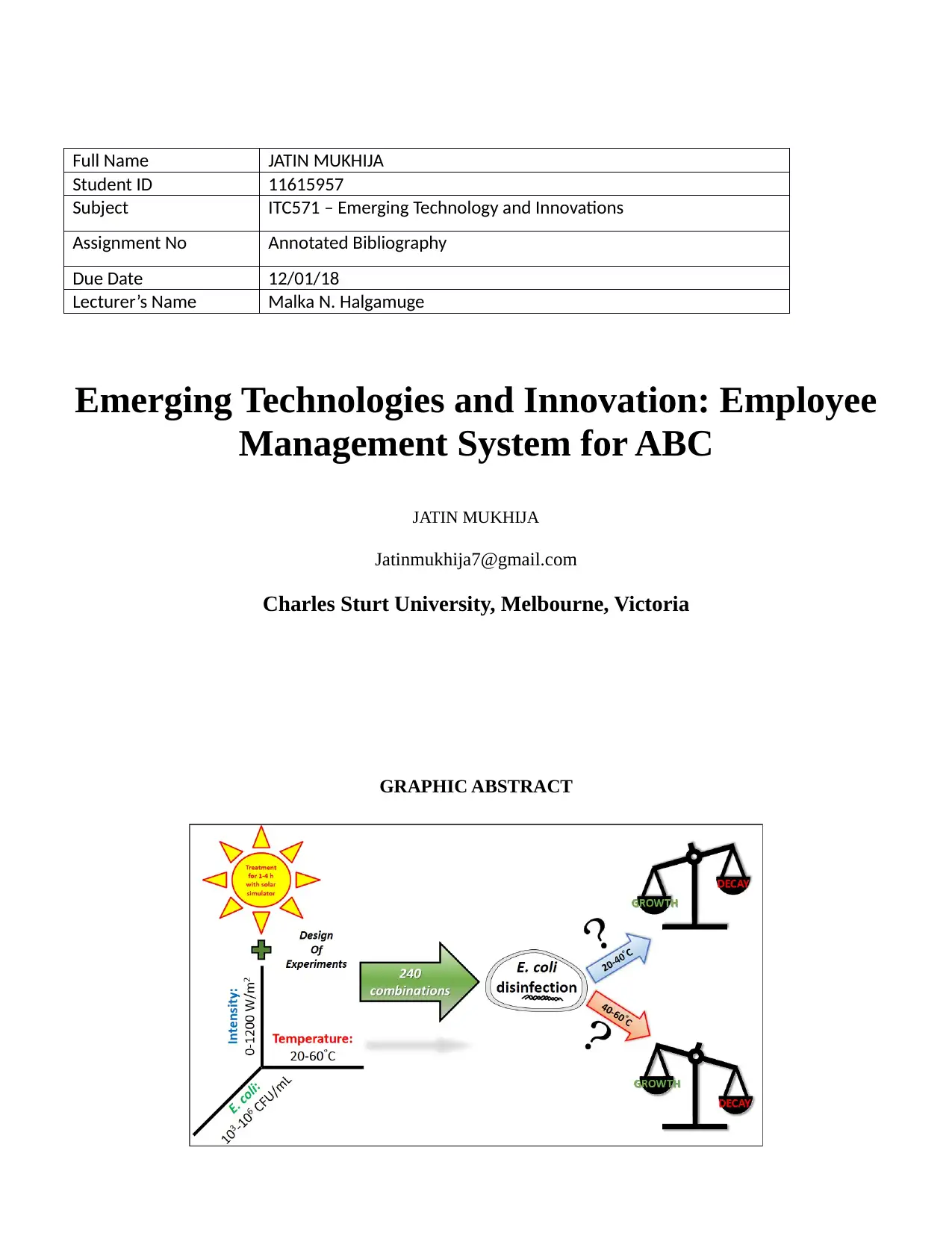
Full Name JATIN MUKHIJA
Student ID 11615957
Subject ITC571 – Emerging Technology and Innovations
Assignment No Annotated Bibliography
Due Date 12/01/18
Lecturer’s Name Malka N. Halgamuge
Emerging Technologies and Innovation: Employee
Management System for ABC
JATIN MUKHIJA
Jatinmukhija7@gmail.com
Charles Sturt University, Melbourne, Victoria
GRAPHIC ABSTRACT
Student ID 11615957
Subject ITC571 – Emerging Technology and Innovations
Assignment No Annotated Bibliography
Due Date 12/01/18
Lecturer’s Name Malka N. Halgamuge
Emerging Technologies and Innovation: Employee
Management System for ABC
JATIN MUKHIJA
Jatinmukhija7@gmail.com
Charles Sturt University, Melbourne, Victoria
GRAPHIC ABSTRACT
Paraphrase This Document
Need a fresh take? Get an instant paraphrase of this document with our AI Paraphraser

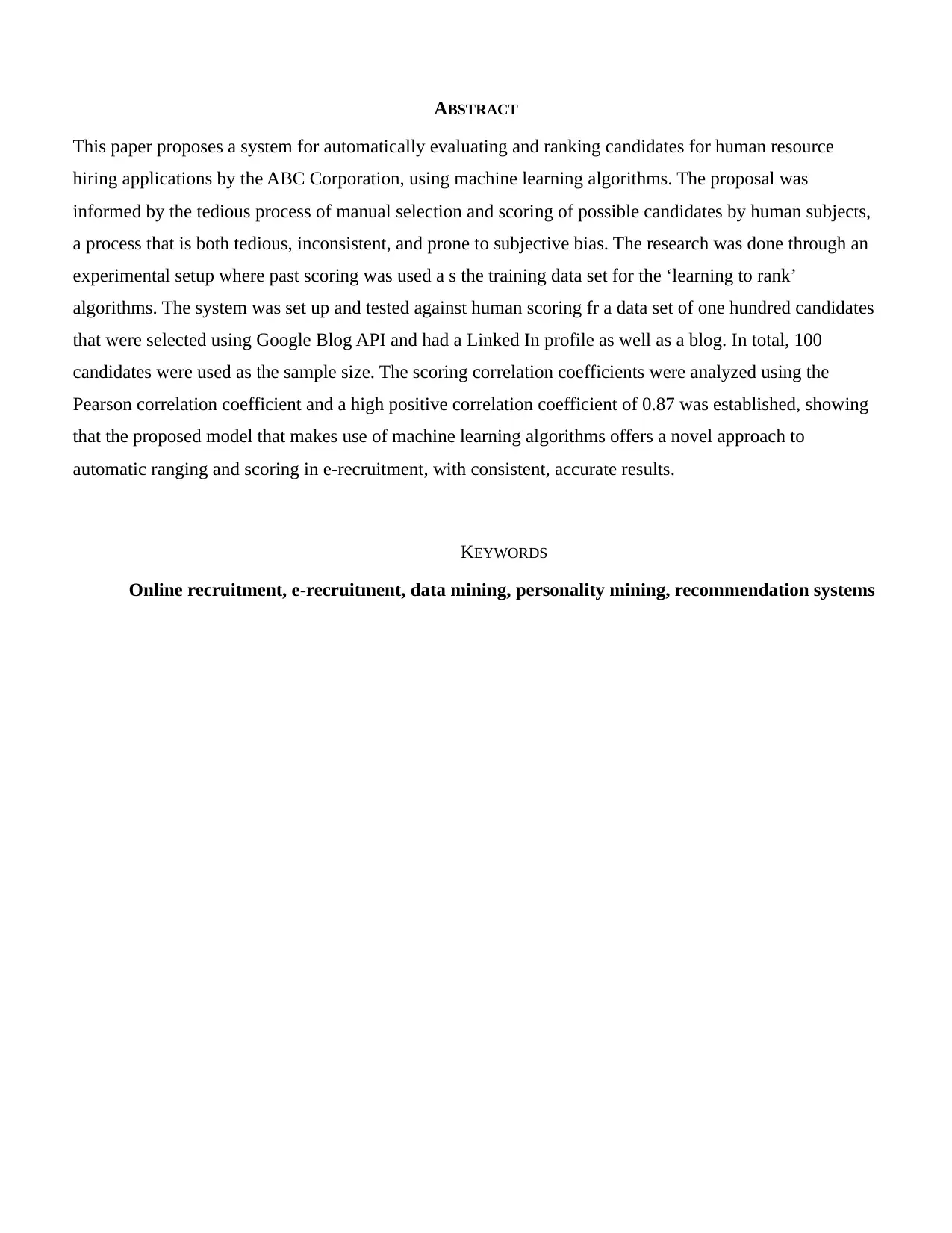
ABSTRACT
This paper proposes a system for automatically evaluating and ranking candidates for human resource
hiring applications by the ABC Corporation, using machine learning algorithms. The proposal was
informed by the tedious process of manual selection and scoring of possible candidates by human subjects,
a process that is both tedious, inconsistent, and prone to subjective bias. The research was done through an
experimental setup where past scoring was used a s the training data set for the ‘learning to rank’
algorithms. The system was set up and tested against human scoring fr a data set of one hundred candidates
that were selected using Google Blog API and had a Linked In profile as well as a blog. In total, 100
candidates were used as the sample size. The scoring correlation coefficients were analyzed using the
Pearson correlation coefficient and a high positive correlation coefficient of 0.87 was established, showing
that the proposed model that makes use of machine learning algorithms offers a novel approach to
automatic ranging and scoring in e-recruitment, with consistent, accurate results.
KEYWORDS
Online recruitment, e-recruitment, data mining, personality mining, recommendation systems
This paper proposes a system for automatically evaluating and ranking candidates for human resource
hiring applications by the ABC Corporation, using machine learning algorithms. The proposal was
informed by the tedious process of manual selection and scoring of possible candidates by human subjects,
a process that is both tedious, inconsistent, and prone to subjective bias. The research was done through an
experimental setup where past scoring was used a s the training data set for the ‘learning to rank’
algorithms. The system was set up and tested against human scoring fr a data set of one hundred candidates
that were selected using Google Blog API and had a Linked In profile as well as a blog. In total, 100
candidates were used as the sample size. The scoring correlation coefficients were analyzed using the
Pearson correlation coefficient and a high positive correlation coefficient of 0.87 was established, showing
that the proposed model that makes use of machine learning algorithms offers a novel approach to
automatic ranging and scoring in e-recruitment, with consistent, accurate results.
KEYWORDS
Online recruitment, e-recruitment, data mining, personality mining, recommendation systems
⊘ This is a preview!⊘
Do you want full access?
Subscribe today to unlock all pages.

Trusted by 1+ million students worldwide
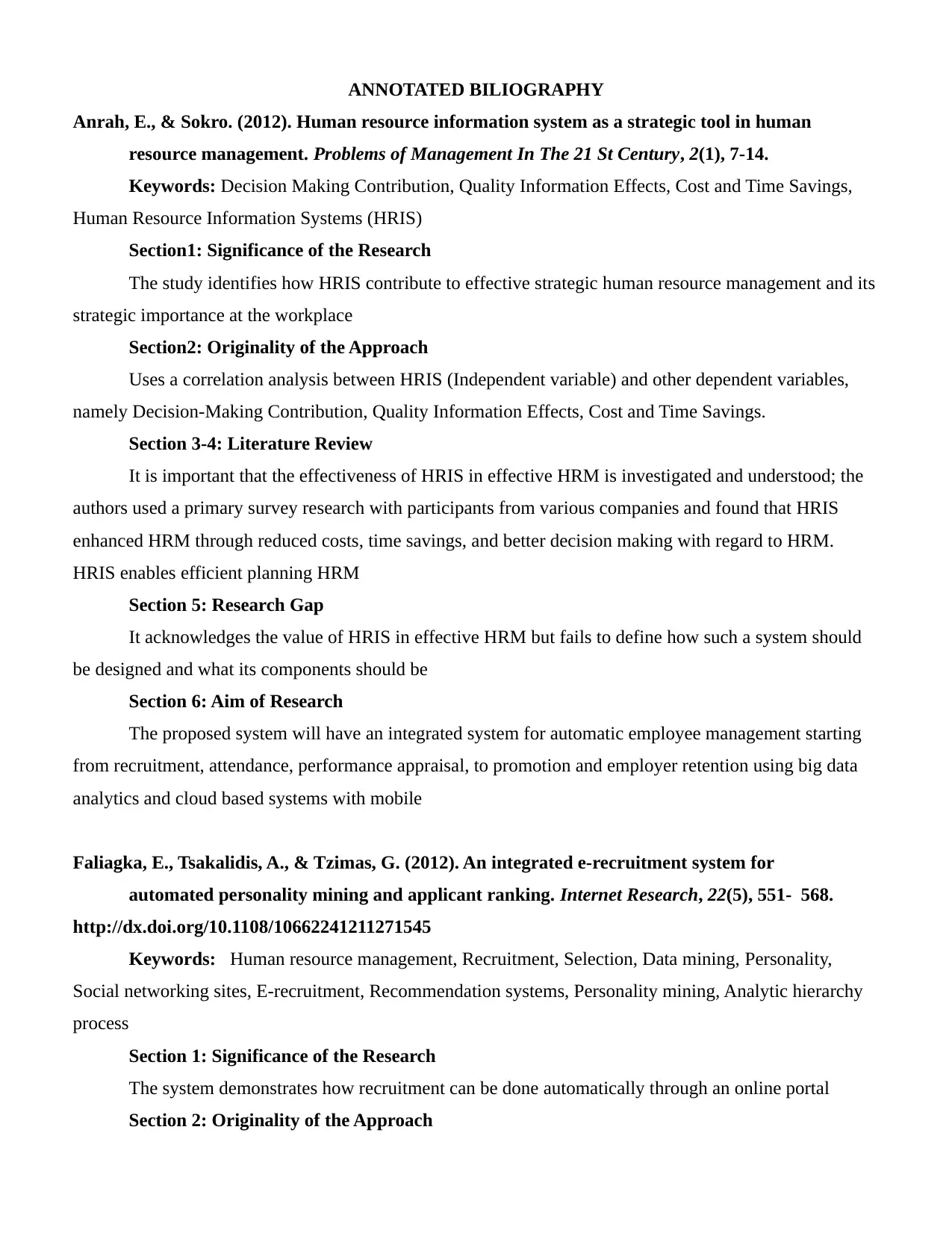
ANNOTATED BILIOGRAPHY
Anrah, E., & Sokro. (2012). Human resource information system as a strategic tool in human
resource management. Problems of Management In The 21 St Century, 2(1), 7-14.
Keywords: Decision Making Contribution, Quality Information Effects, Cost and Time Savings,
Human Resource Information Systems (HRIS)
Section1: Significance of the Research
The study identifies how HRIS contribute to effective strategic human resource management and its
strategic importance at the workplace
Section2: Originality of the Approach
Uses a correlation analysis between HRIS (Independent variable) and other dependent variables,
namely Decision-Making Contribution, Quality Information Effects, Cost and Time Savings.
Section 3-4: Literature Review
It is important that the effectiveness of HRIS in effective HRM is investigated and understood; the
authors used a primary survey research with participants from various companies and found that HRIS
enhanced HRM through reduced costs, time savings, and better decision making with regard to HRM.
HRIS enables efficient planning HRM
Section 5: Research Gap
It acknowledges the value of HRIS in effective HRM but fails to define how such a system should
be designed and what its components should be
Section 6: Aim of Research
The proposed system will have an integrated system for automatic employee management starting
from recruitment, attendance, performance appraisal, to promotion and employer retention using big data
analytics and cloud based systems with mobile
Faliagka, E., Tsakalidis, A., & Tzimas, G. (2012). An integrated e‐recruitment system for
automated personality mining and applicant ranking. Internet Research, 22(5), 551- 568.
http://dx.doi.org/10.1108/10662241211271545
Keywords: Human resource management, Recruitment, Selection, Data mining, Personality,
Social networking sites, E‐recruitment, Recommendation systems, Personality mining, Analytic hierarchy
process
Section 1: Significance of the Research
The system demonstrates how recruitment can be done automatically through an online portal
Section 2: Originality of the Approach
Anrah, E., & Sokro. (2012). Human resource information system as a strategic tool in human
resource management. Problems of Management In The 21 St Century, 2(1), 7-14.
Keywords: Decision Making Contribution, Quality Information Effects, Cost and Time Savings,
Human Resource Information Systems (HRIS)
Section1: Significance of the Research
The study identifies how HRIS contribute to effective strategic human resource management and its
strategic importance at the workplace
Section2: Originality of the Approach
Uses a correlation analysis between HRIS (Independent variable) and other dependent variables,
namely Decision-Making Contribution, Quality Information Effects, Cost and Time Savings.
Section 3-4: Literature Review
It is important that the effectiveness of HRIS in effective HRM is investigated and understood; the
authors used a primary survey research with participants from various companies and found that HRIS
enhanced HRM through reduced costs, time savings, and better decision making with regard to HRM.
HRIS enables efficient planning HRM
Section 5: Research Gap
It acknowledges the value of HRIS in effective HRM but fails to define how such a system should
be designed and what its components should be
Section 6: Aim of Research
The proposed system will have an integrated system for automatic employee management starting
from recruitment, attendance, performance appraisal, to promotion and employer retention using big data
analytics and cloud based systems with mobile
Faliagka, E., Tsakalidis, A., & Tzimas, G. (2012). An integrated e‐recruitment system for
automated personality mining and applicant ranking. Internet Research, 22(5), 551- 568.
http://dx.doi.org/10.1108/10662241211271545
Keywords: Human resource management, Recruitment, Selection, Data mining, Personality,
Social networking sites, E‐recruitment, Recommendation systems, Personality mining, Analytic hierarchy
process
Section 1: Significance of the Research
The system demonstrates how recruitment can be done automatically through an online portal
Section 2: Originality of the Approach
Paraphrase This Document
Need a fresh take? Get an instant paraphrase of this document with our AI Paraphraser
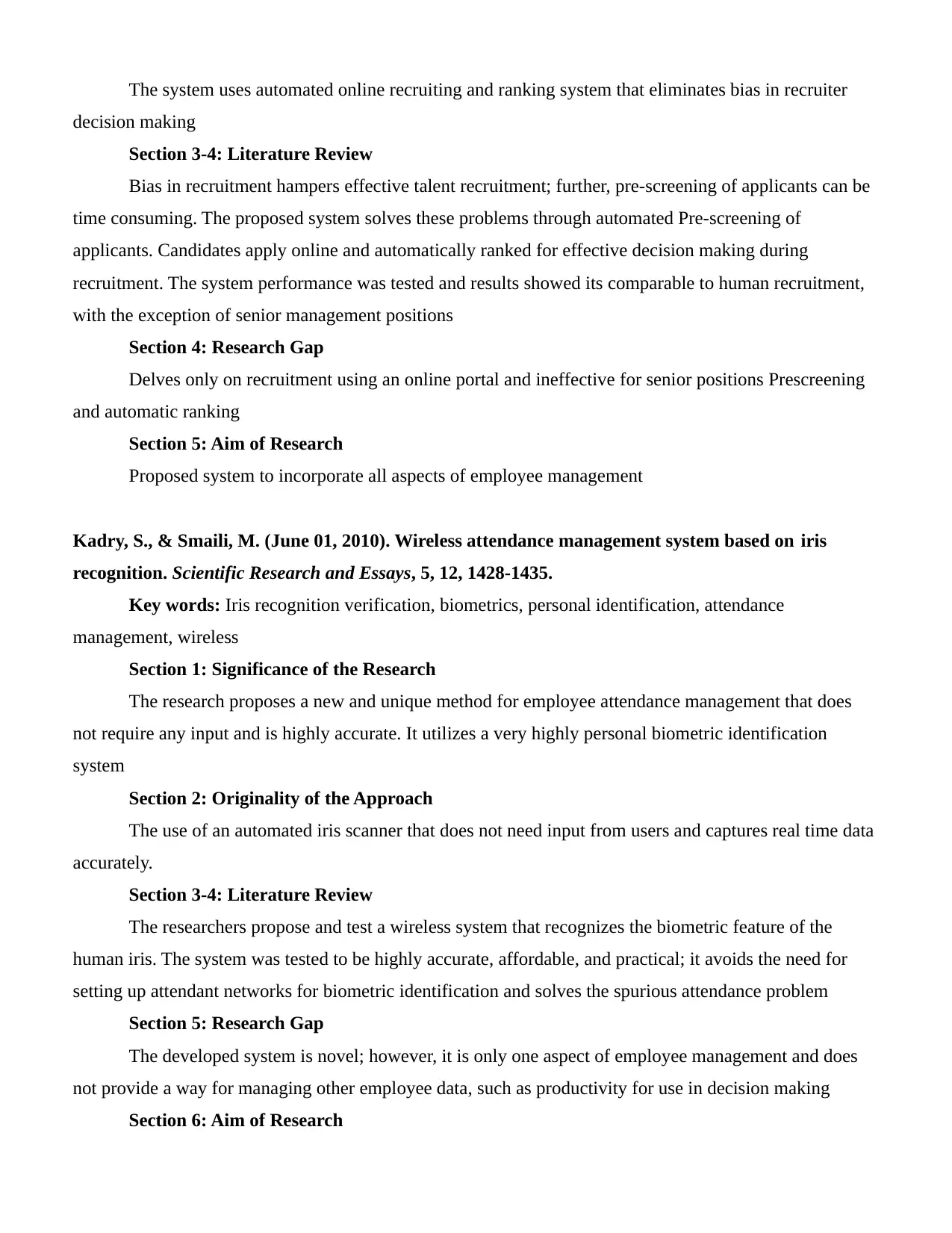
The system uses automated online recruiting and ranking system that eliminates bias in recruiter
decision making
Section 3-4: Literature Review
Bias in recruitment hampers effective talent recruitment; further, pre-screening of applicants can be
time consuming. The proposed system solves these problems through automated Pre-screening of
applicants. Candidates apply online and automatically ranked for effective decision making during
recruitment. The system performance was tested and results showed its comparable to human recruitment,
with the exception of senior management positions
Section 4: Research Gap
Delves only on recruitment using an online portal and ineffective for senior positions Prescreening
and automatic ranking
Section 5: Aim of Research
Proposed system to incorporate all aspects of employee management
Kadry, S., & Smaili, M. (June 01, 2010). Wireless attendance management system based on iris
recognition. Scientific Research and Essays, 5, 12, 1428-1435.
Key words: Iris recognition verification, biometrics, personal identification, attendance
management, wireless
Section 1: Significance of the Research
The research proposes a new and unique method for employee attendance management that does
not require any input and is highly accurate. It utilizes a very highly personal biometric identification
system
Section 2: Originality of the Approach
The use of an automated iris scanner that does not need input from users and captures real time data
accurately.
Section 3-4: Literature Review
The researchers propose and test a wireless system that recognizes the biometric feature of the
human iris. The system was tested to be highly accurate, affordable, and practical; it avoids the need for
setting up attendant networks for biometric identification and solves the spurious attendance problem
Section 5: Research Gap
The developed system is novel; however, it is only one aspect of employee management and does
not provide a way for managing other employee data, such as productivity for use in decision making
Section 6: Aim of Research
decision making
Section 3-4: Literature Review
Bias in recruitment hampers effective talent recruitment; further, pre-screening of applicants can be
time consuming. The proposed system solves these problems through automated Pre-screening of
applicants. Candidates apply online and automatically ranked for effective decision making during
recruitment. The system performance was tested and results showed its comparable to human recruitment,
with the exception of senior management positions
Section 4: Research Gap
Delves only on recruitment using an online portal and ineffective for senior positions Prescreening
and automatic ranking
Section 5: Aim of Research
Proposed system to incorporate all aspects of employee management
Kadry, S., & Smaili, M. (June 01, 2010). Wireless attendance management system based on iris
recognition. Scientific Research and Essays, 5, 12, 1428-1435.
Key words: Iris recognition verification, biometrics, personal identification, attendance
management, wireless
Section 1: Significance of the Research
The research proposes a new and unique method for employee attendance management that does
not require any input and is highly accurate. It utilizes a very highly personal biometric identification
system
Section 2: Originality of the Approach
The use of an automated iris scanner that does not need input from users and captures real time data
accurately.
Section 3-4: Literature Review
The researchers propose and test a wireless system that recognizes the biometric feature of the
human iris. The system was tested to be highly accurate, affordable, and practical; it avoids the need for
setting up attendant networks for biometric identification and solves the spurious attendance problem
Section 5: Research Gap
The developed system is novel; however, it is only one aspect of employee management and does
not provide a way for managing other employee data, such as productivity for use in decision making
Section 6: Aim of Research
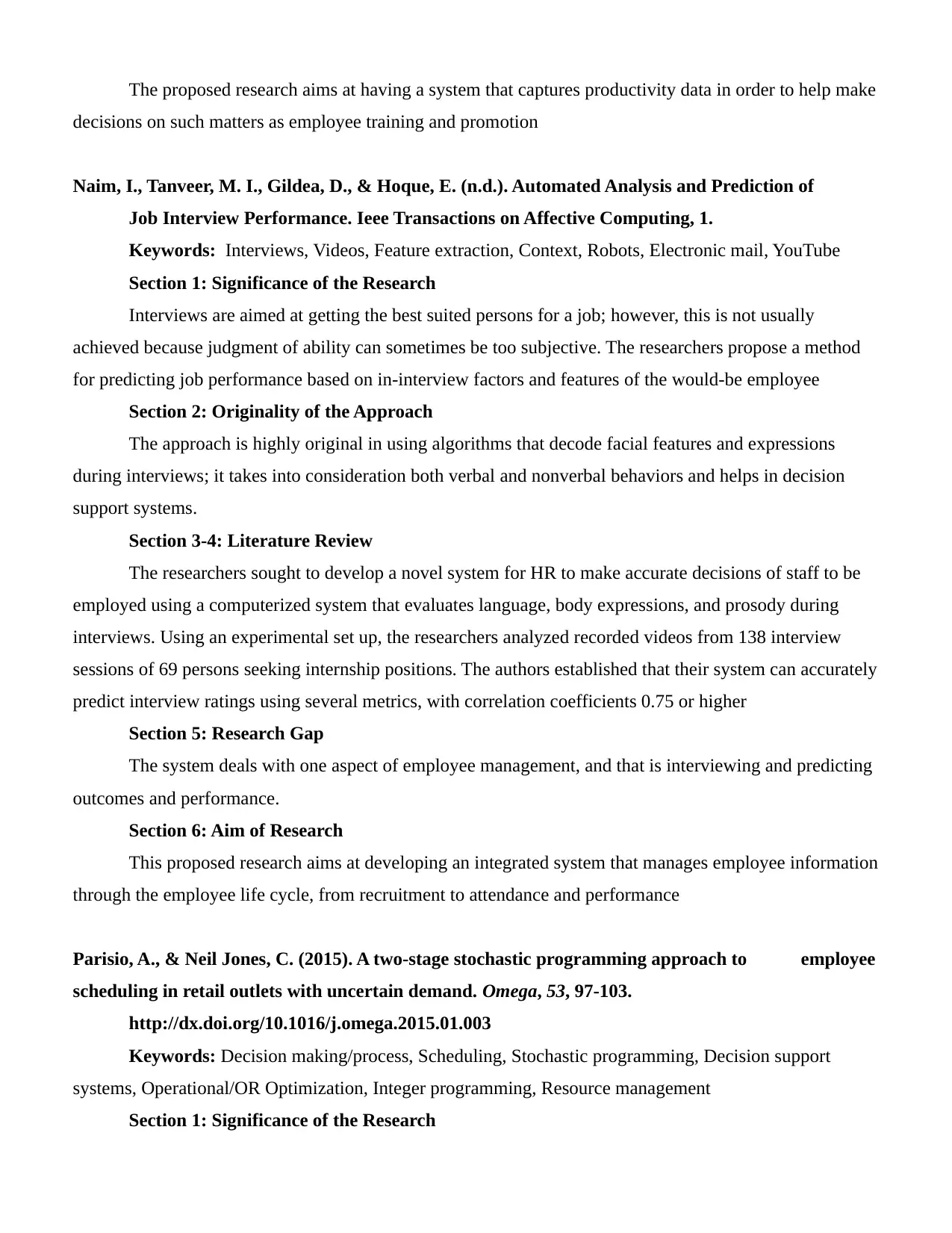
The proposed research aims at having a system that captures productivity data in order to help make
decisions on such matters as employee training and promotion
Naim, I., Tanveer, M. I., Gildea, D., & Hoque, E. (n.d.). Automated Analysis and Prediction of
Job Interview Performance. Ieee Transactions on Affective Computing, 1.
Keywords: Interviews, Videos, Feature extraction, Context, Robots, Electronic mail, YouTube
Section 1: Significance of the Research
Interviews are aimed at getting the best suited persons for a job; however, this is not usually
achieved because judgment of ability can sometimes be too subjective. The researchers propose a method
for predicting job performance based on in-interview factors and features of the would-be employee
Section 2: Originality of the Approach
The approach is highly original in using algorithms that decode facial features and expressions
during interviews; it takes into consideration both verbal and nonverbal behaviors and helps in decision
support systems.
Section 3-4: Literature Review
The researchers sought to develop a novel system for HR to make accurate decisions of staff to be
employed using a computerized system that evaluates language, body expressions, and prosody during
interviews. Using an experimental set up, the researchers analyzed recorded videos from 138 interview
sessions of 69 persons seeking internship positions. The authors established that their system can accurately
predict interview ratings using several metrics, with correlation coefficients 0.75 or higher
Section 5: Research Gap
The system deals with one aspect of employee management, and that is interviewing and predicting
outcomes and performance.
Section 6: Aim of Research
This proposed research aims at developing an integrated system that manages employee information
through the employee life cycle, from recruitment to attendance and performance
Parisio, A., & Neil Jones, C. (2015). A two-stage stochastic programming approach to employee
scheduling in retail outlets with uncertain demand. Omega, 53, 97-103.
http://dx.doi.org/10.1016/j.omega.2015.01.003
Keywords: Decision making/process, Scheduling, Stochastic programming, Decision support
systems, Operational/OR Optimization, Integer programming, Resource management
Section 1: Significance of the Research
decisions on such matters as employee training and promotion
Naim, I., Tanveer, M. I., Gildea, D., & Hoque, E. (n.d.). Automated Analysis and Prediction of
Job Interview Performance. Ieee Transactions on Affective Computing, 1.
Keywords: Interviews, Videos, Feature extraction, Context, Robots, Electronic mail, YouTube
Section 1: Significance of the Research
Interviews are aimed at getting the best suited persons for a job; however, this is not usually
achieved because judgment of ability can sometimes be too subjective. The researchers propose a method
for predicting job performance based on in-interview factors and features of the would-be employee
Section 2: Originality of the Approach
The approach is highly original in using algorithms that decode facial features and expressions
during interviews; it takes into consideration both verbal and nonverbal behaviors and helps in decision
support systems.
Section 3-4: Literature Review
The researchers sought to develop a novel system for HR to make accurate decisions of staff to be
employed using a computerized system that evaluates language, body expressions, and prosody during
interviews. Using an experimental set up, the researchers analyzed recorded videos from 138 interview
sessions of 69 persons seeking internship positions. The authors established that their system can accurately
predict interview ratings using several metrics, with correlation coefficients 0.75 or higher
Section 5: Research Gap
The system deals with one aspect of employee management, and that is interviewing and predicting
outcomes and performance.
Section 6: Aim of Research
This proposed research aims at developing an integrated system that manages employee information
through the employee life cycle, from recruitment to attendance and performance
Parisio, A., & Neil Jones, C. (2015). A two-stage stochastic programming approach to employee
scheduling in retail outlets with uncertain demand. Omega, 53, 97-103.
http://dx.doi.org/10.1016/j.omega.2015.01.003
Keywords: Decision making/process, Scheduling, Stochastic programming, Decision support
systems, Operational/OR Optimization, Integer programming, Resource management
Section 1: Significance of the Research
⊘ This is a preview!⊘
Do you want full access?
Subscribe today to unlock all pages.

Trusted by 1+ million students worldwide
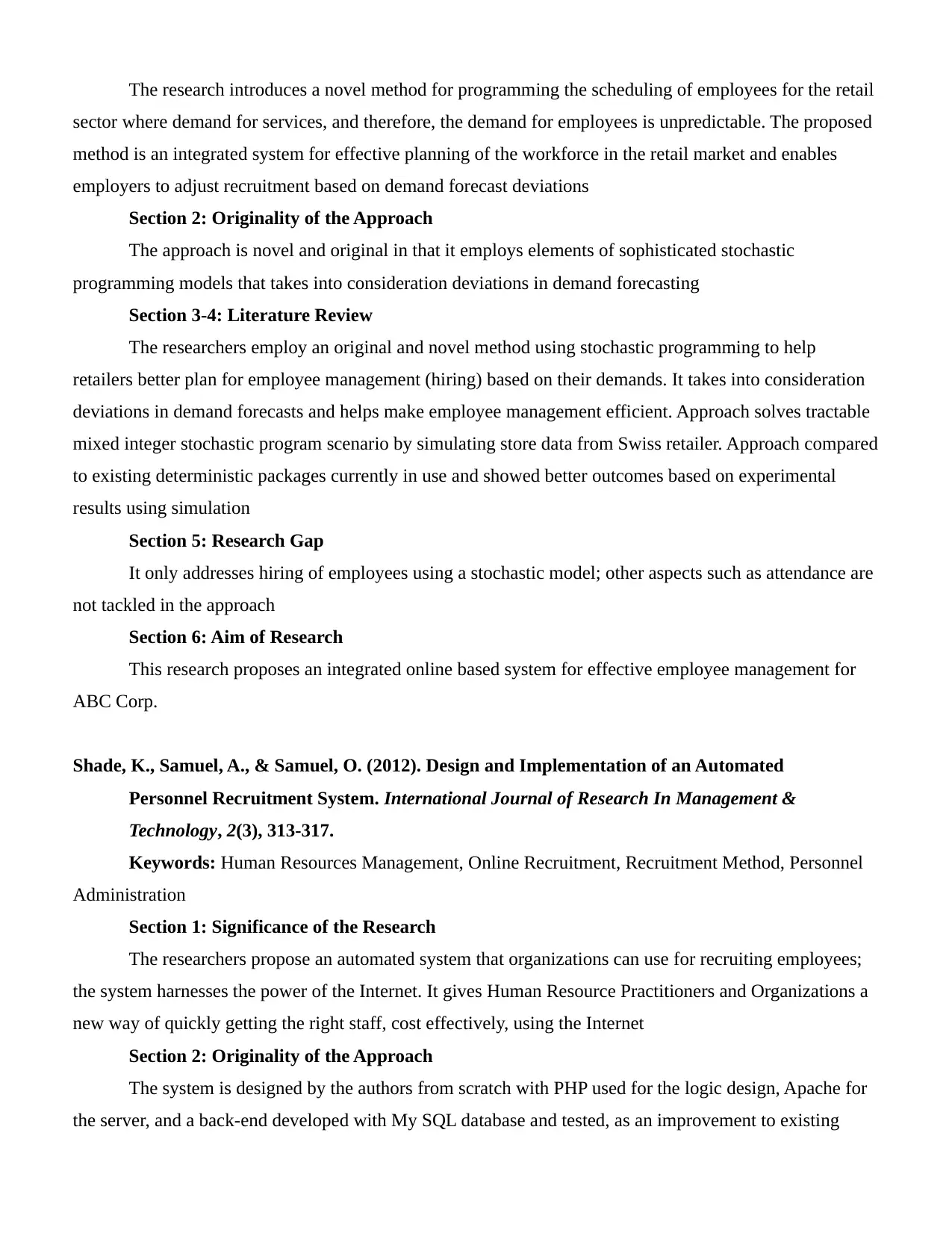
The research introduces a novel method for programming the scheduling of employees for the retail
sector where demand for services, and therefore, the demand for employees is unpredictable. The proposed
method is an integrated system for effective planning of the workforce in the retail market and enables
employers to adjust recruitment based on demand forecast deviations
Section 2: Originality of the Approach
The approach is novel and original in that it employs elements of sophisticated stochastic
programming models that takes into consideration deviations in demand forecasting
Section 3-4: Literature Review
The researchers employ an original and novel method using stochastic programming to help
retailers better plan for employee management (hiring) based on their demands. It takes into consideration
deviations in demand forecasts and helps make employee management efficient. Approach solves tractable
mixed integer stochastic program scenario by simulating store data from Swiss retailer. Approach compared
to existing deterministic packages currently in use and showed better outcomes based on experimental
results using simulation
Section 5: Research Gap
It only addresses hiring of employees using a stochastic model; other aspects such as attendance are
not tackled in the approach
Section 6: Aim of Research
This research proposes an integrated online based system for effective employee management for
ABC Corp.
Shade, K., Samuel, A., & Samuel, O. (2012). Design and Implementation of an Automated
Personnel Recruitment System. International Journal of Research In Management &
Technology, 2(3), 313-317.
Keywords: Human Resources Management, Online Recruitment, Recruitment Method, Personnel
Administration
Section 1: Significance of the Research
The researchers propose an automated system that organizations can use for recruiting employees;
the system harnesses the power of the Internet. It gives Human Resource Practitioners and Organizations a
new way of quickly getting the right staff, cost effectively, using the Internet
Section 2: Originality of the Approach
The system is designed by the authors from scratch with PHP used for the logic design, Apache for
the server, and a back-end developed with My SQL database and tested, as an improvement to existing
sector where demand for services, and therefore, the demand for employees is unpredictable. The proposed
method is an integrated system for effective planning of the workforce in the retail market and enables
employers to adjust recruitment based on demand forecast deviations
Section 2: Originality of the Approach
The approach is novel and original in that it employs elements of sophisticated stochastic
programming models that takes into consideration deviations in demand forecasting
Section 3-4: Literature Review
The researchers employ an original and novel method using stochastic programming to help
retailers better plan for employee management (hiring) based on their demands. It takes into consideration
deviations in demand forecasts and helps make employee management efficient. Approach solves tractable
mixed integer stochastic program scenario by simulating store data from Swiss retailer. Approach compared
to existing deterministic packages currently in use and showed better outcomes based on experimental
results using simulation
Section 5: Research Gap
It only addresses hiring of employees using a stochastic model; other aspects such as attendance are
not tackled in the approach
Section 6: Aim of Research
This research proposes an integrated online based system for effective employee management for
ABC Corp.
Shade, K., Samuel, A., & Samuel, O. (2012). Design and Implementation of an Automated
Personnel Recruitment System. International Journal of Research In Management &
Technology, 2(3), 313-317.
Keywords: Human Resources Management, Online Recruitment, Recruitment Method, Personnel
Administration
Section 1: Significance of the Research
The researchers propose an automated system that organizations can use for recruiting employees;
the system harnesses the power of the Internet. It gives Human Resource Practitioners and Organizations a
new way of quickly getting the right staff, cost effectively, using the Internet
Section 2: Originality of the Approach
The system is designed by the authors from scratch with PHP used for the logic design, Apache for
the server, and a back-end developed with My SQL database and tested, as an improvement to existing
Paraphrase This Document
Need a fresh take? Get an instant paraphrase of this document with our AI Paraphraser
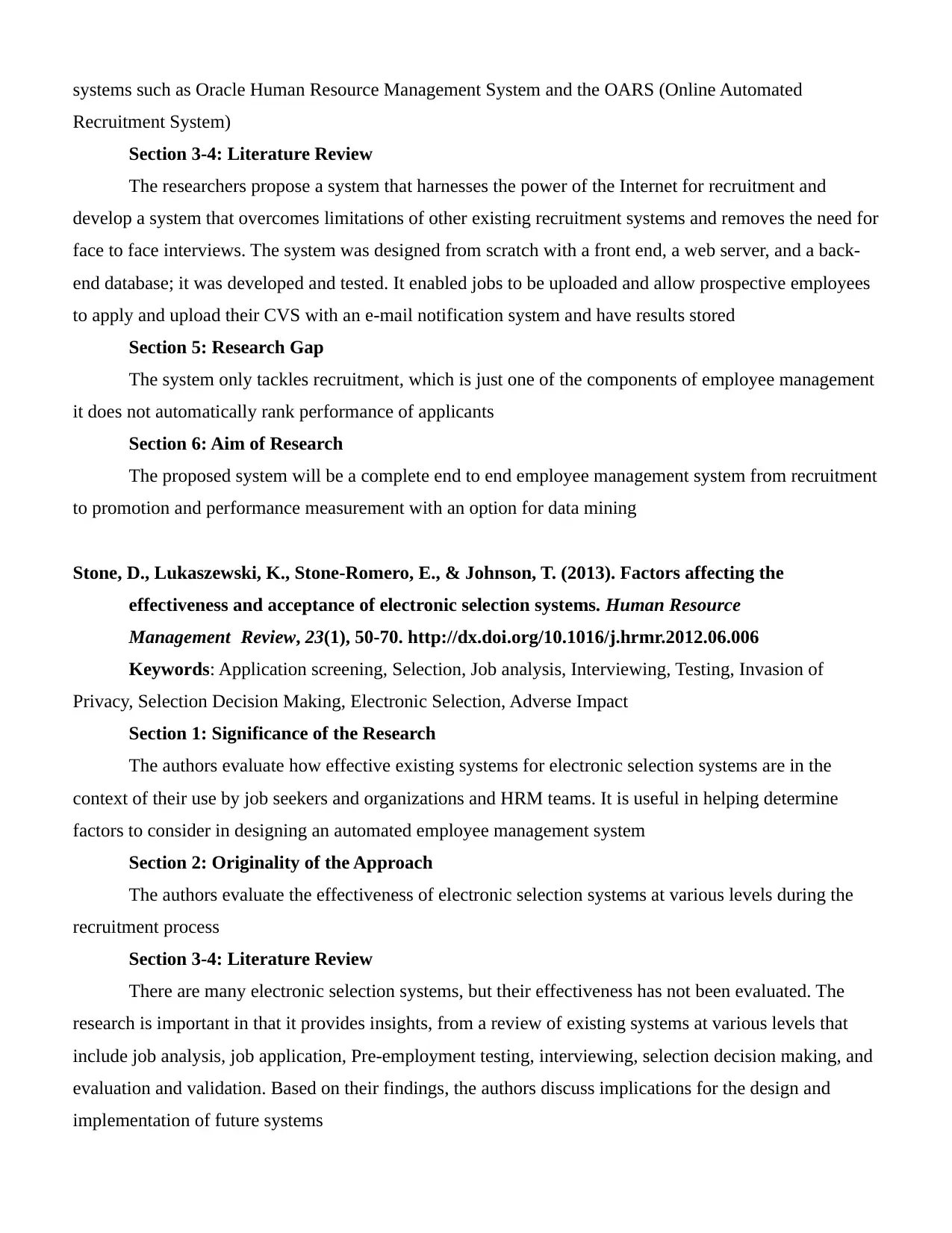
systems such as Oracle Human Resource Management System and the OARS (Online Automated
Recruitment System)
Section 3-4: Literature Review
The researchers propose a system that harnesses the power of the Internet for recruitment and
develop a system that overcomes limitations of other existing recruitment systems and removes the need for
face to face interviews. The system was designed from scratch with a front end, a web server, and a back-
end database; it was developed and tested. It enabled jobs to be uploaded and allow prospective employees
to apply and upload their CVS with an e-mail notification system and have results stored
Section 5: Research Gap
The system only tackles recruitment, which is just one of the components of employee management
it does not automatically rank performance of applicants
Section 6: Aim of Research
The proposed system will be a complete end to end employee management system from recruitment
to promotion and performance measurement with an option for data mining
Stone, D., Lukaszewski, K., Stone-Romero, E., & Johnson, T. (2013). Factors affecting the
effectiveness and acceptance of electronic selection systems. Human Resource
Management Review, 23(1), 50-70. http://dx.doi.org/10.1016/j.hrmr.2012.06.006
Keywords: Application screening, Selection, Job analysis, Interviewing, Testing, Invasion of
Privacy, Selection Decision Making, Electronic Selection, Adverse Impact
Section 1: Significance of the Research
The authors evaluate how effective existing systems for electronic selection systems are in the
context of their use by job seekers and organizations and HRM teams. It is useful in helping determine
factors to consider in designing an automated employee management system
Section 2: Originality of the Approach
The authors evaluate the effectiveness of electronic selection systems at various levels during the
recruitment process
Section 3-4: Literature Review
There are many electronic selection systems, but their effectiveness has not been evaluated. The
research is important in that it provides insights, from a review of existing systems at various levels that
include job analysis, job application, Pre-employment testing, interviewing, selection decision making, and
evaluation and validation. Based on their findings, the authors discuss implications for the design and
implementation of future systems
Recruitment System)
Section 3-4: Literature Review
The researchers propose a system that harnesses the power of the Internet for recruitment and
develop a system that overcomes limitations of other existing recruitment systems and removes the need for
face to face interviews. The system was designed from scratch with a front end, a web server, and a back-
end database; it was developed and tested. It enabled jobs to be uploaded and allow prospective employees
to apply and upload their CVS with an e-mail notification system and have results stored
Section 5: Research Gap
The system only tackles recruitment, which is just one of the components of employee management
it does not automatically rank performance of applicants
Section 6: Aim of Research
The proposed system will be a complete end to end employee management system from recruitment
to promotion and performance measurement with an option for data mining
Stone, D., Lukaszewski, K., Stone-Romero, E., & Johnson, T. (2013). Factors affecting the
effectiveness and acceptance of electronic selection systems. Human Resource
Management Review, 23(1), 50-70. http://dx.doi.org/10.1016/j.hrmr.2012.06.006
Keywords: Application screening, Selection, Job analysis, Interviewing, Testing, Invasion of
Privacy, Selection Decision Making, Electronic Selection, Adverse Impact
Section 1: Significance of the Research
The authors evaluate how effective existing systems for electronic selection systems are in the
context of their use by job seekers and organizations and HRM teams. It is useful in helping determine
factors to consider in designing an automated employee management system
Section 2: Originality of the Approach
The authors evaluate the effectiveness of electronic selection systems at various levels during the
recruitment process
Section 3-4: Literature Review
There are many electronic selection systems, but their effectiveness has not been evaluated. The
research is important in that it provides insights, from a review of existing systems at various levels that
include job analysis, job application, Pre-employment testing, interviewing, selection decision making, and
evaluation and validation. Based on their findings, the authors discuss implications for the design and
implementation of future systems
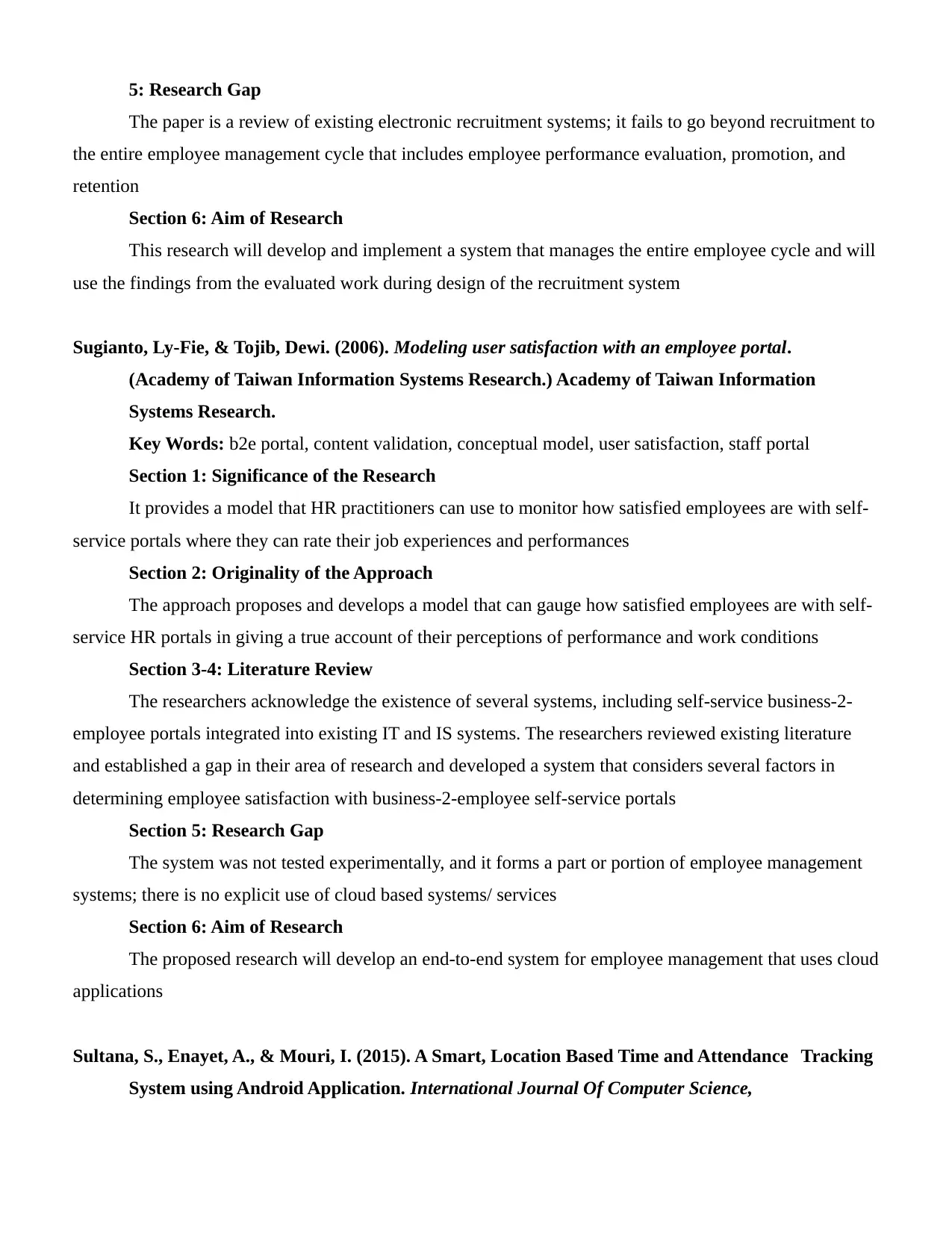
5: Research Gap
The paper is a review of existing electronic recruitment systems; it fails to go beyond recruitment to
the entire employee management cycle that includes employee performance evaluation, promotion, and
retention
Section 6: Aim of Research
This research will develop and implement a system that manages the entire employee cycle and will
use the findings from the evaluated work during design of the recruitment system
Sugianto, Ly-Fie, & Tojib, Dewi. (2006). Modeling user satisfaction with an employee portal.
(Academy of Taiwan Information Systems Research.) Academy of Taiwan Information
Systems Research.
Key Words: b2e portal, content validation, conceptual model, user satisfaction, staff portal
Section 1: Significance of the Research
It provides a model that HR practitioners can use to monitor how satisfied employees are with self-
service portals where they can rate their job experiences and performances
Section 2: Originality of the Approach
The approach proposes and develops a model that can gauge how satisfied employees are with self-
service HR portals in giving a true account of their perceptions of performance and work conditions
Section 3-4: Literature Review
The researchers acknowledge the existence of several systems, including self-service business-2-
employee portals integrated into existing IT and IS systems. The researchers reviewed existing literature
and established a gap in their area of research and developed a system that considers several factors in
determining employee satisfaction with business-2-employee self-service portals
Section 5: Research Gap
The system was not tested experimentally, and it forms a part or portion of employee management
systems; there is no explicit use of cloud based systems/ services
Section 6: Aim of Research
The proposed research will develop an end-to-end system for employee management that uses cloud
applications
Sultana, S., Enayet, A., & Mouri, I. (2015). A Smart, Location Based Time and Attendance Tracking
System using Android Application. International Journal Of Computer Science,
The paper is a review of existing electronic recruitment systems; it fails to go beyond recruitment to
the entire employee management cycle that includes employee performance evaluation, promotion, and
retention
Section 6: Aim of Research
This research will develop and implement a system that manages the entire employee cycle and will
use the findings from the evaluated work during design of the recruitment system
Sugianto, Ly-Fie, & Tojib, Dewi. (2006). Modeling user satisfaction with an employee portal.
(Academy of Taiwan Information Systems Research.) Academy of Taiwan Information
Systems Research.
Key Words: b2e portal, content validation, conceptual model, user satisfaction, staff portal
Section 1: Significance of the Research
It provides a model that HR practitioners can use to monitor how satisfied employees are with self-
service portals where they can rate their job experiences and performances
Section 2: Originality of the Approach
The approach proposes and develops a model that can gauge how satisfied employees are with self-
service HR portals in giving a true account of their perceptions of performance and work conditions
Section 3-4: Literature Review
The researchers acknowledge the existence of several systems, including self-service business-2-
employee portals integrated into existing IT and IS systems. The researchers reviewed existing literature
and established a gap in their area of research and developed a system that considers several factors in
determining employee satisfaction with business-2-employee self-service portals
Section 5: Research Gap
The system was not tested experimentally, and it forms a part or portion of employee management
systems; there is no explicit use of cloud based systems/ services
Section 6: Aim of Research
The proposed research will develop an end-to-end system for employee management that uses cloud
applications
Sultana, S., Enayet, A., & Mouri, I. (2015). A Smart, Location Based Time and Attendance Tracking
System using Android Application. International Journal Of Computer Science,
⊘ This is a preview!⊘
Do you want full access?
Subscribe today to unlock all pages.

Trusted by 1+ million students worldwide
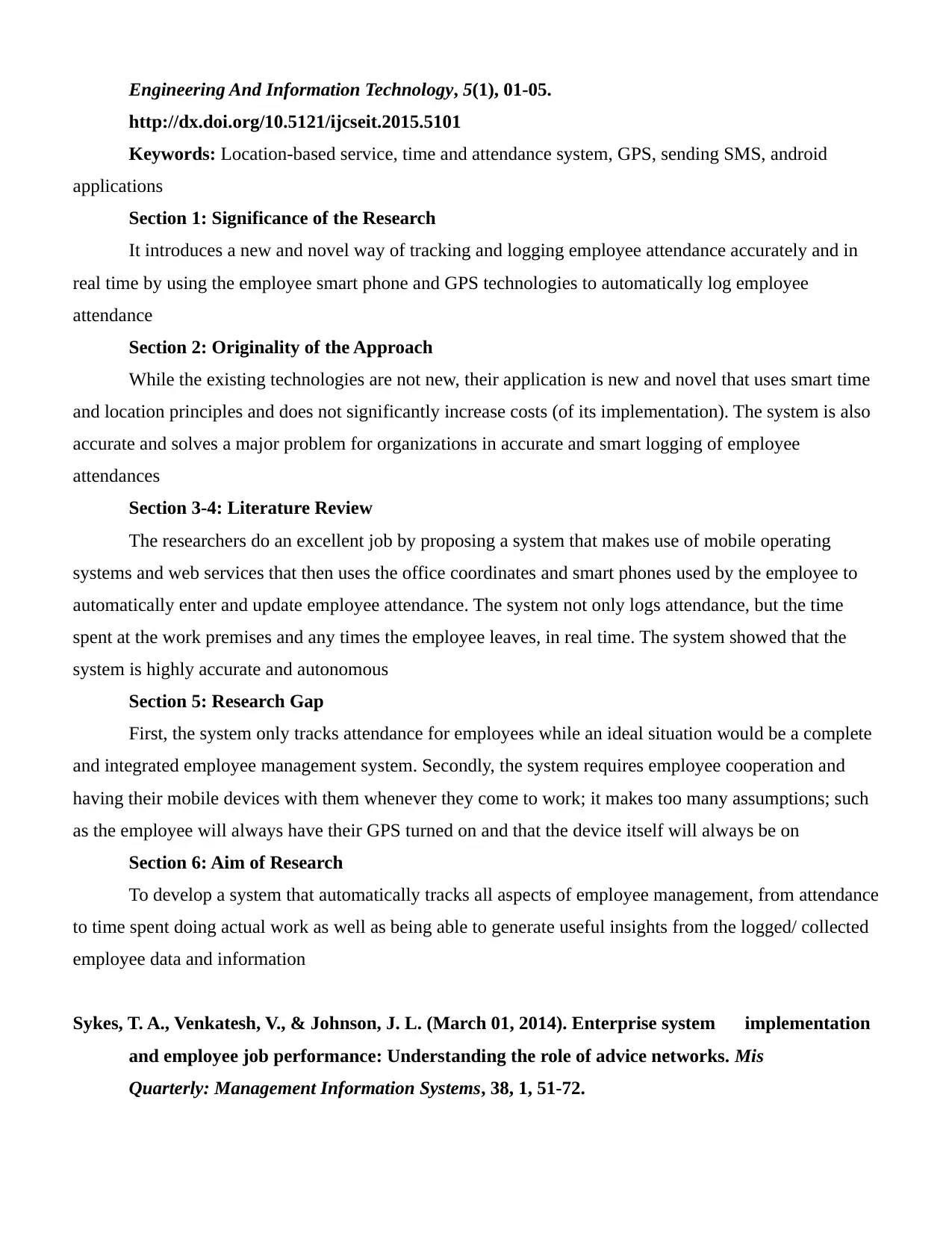
Engineering And Information Technology, 5(1), 01-05.
http://dx.doi.org/10.5121/ijcseit.2015.5101
Keywords: Location-based service, time and attendance system, GPS, sending SMS, android
applications
Section 1: Significance of the Research
It introduces a new and novel way of tracking and logging employee attendance accurately and in
real time by using the employee smart phone and GPS technologies to automatically log employee
attendance
Section 2: Originality of the Approach
While the existing technologies are not new, their application is new and novel that uses smart time
and location principles and does not significantly increase costs (of its implementation). The system is also
accurate and solves a major problem for organizations in accurate and smart logging of employee
attendances
Section 3-4: Literature Review
The researchers do an excellent job by proposing a system that makes use of mobile operating
systems and web services that then uses the office coordinates and smart phones used by the employee to
automatically enter and update employee attendance. The system not only logs attendance, but the time
spent at the work premises and any times the employee leaves, in real time. The system showed that the
system is highly accurate and autonomous
Section 5: Research Gap
First, the system only tracks attendance for employees while an ideal situation would be a complete
and integrated employee management system. Secondly, the system requires employee cooperation and
having their mobile devices with them whenever they come to work; it makes too many assumptions; such
as the employee will always have their GPS turned on and that the device itself will always be on
Section 6: Aim of Research
To develop a system that automatically tracks all aspects of employee management, from attendance
to time spent doing actual work as well as being able to generate useful insights from the logged/ collected
employee data and information
Sykes, T. A., Venkatesh, V., & Johnson, J. L. (March 01, 2014). Enterprise system implementation
and employee job performance: Understanding the role of advice networks. Mis
Quarterly: Management Information Systems, 38, 1, 51-72.
http://dx.doi.org/10.5121/ijcseit.2015.5101
Keywords: Location-based service, time and attendance system, GPS, sending SMS, android
applications
Section 1: Significance of the Research
It introduces a new and novel way of tracking and logging employee attendance accurately and in
real time by using the employee smart phone and GPS technologies to automatically log employee
attendance
Section 2: Originality of the Approach
While the existing technologies are not new, their application is new and novel that uses smart time
and location principles and does not significantly increase costs (of its implementation). The system is also
accurate and solves a major problem for organizations in accurate and smart logging of employee
attendances
Section 3-4: Literature Review
The researchers do an excellent job by proposing a system that makes use of mobile operating
systems and web services that then uses the office coordinates and smart phones used by the employee to
automatically enter and update employee attendance. The system not only logs attendance, but the time
spent at the work premises and any times the employee leaves, in real time. The system showed that the
system is highly accurate and autonomous
Section 5: Research Gap
First, the system only tracks attendance for employees while an ideal situation would be a complete
and integrated employee management system. Secondly, the system requires employee cooperation and
having their mobile devices with them whenever they come to work; it makes too many assumptions; such
as the employee will always have their GPS turned on and that the device itself will always be on
Section 6: Aim of Research
To develop a system that automatically tracks all aspects of employee management, from attendance
to time spent doing actual work as well as being able to generate useful insights from the logged/ collected
employee data and information
Sykes, T. A., Venkatesh, V., & Johnson, J. L. (March 01, 2014). Enterprise system implementation
and employee job performance: Understanding the role of advice networks. Mis
Quarterly: Management Information Systems, 38, 1, 51-72.
Paraphrase This Document
Need a fresh take? Get an instant paraphrase of this document with our AI Paraphraser
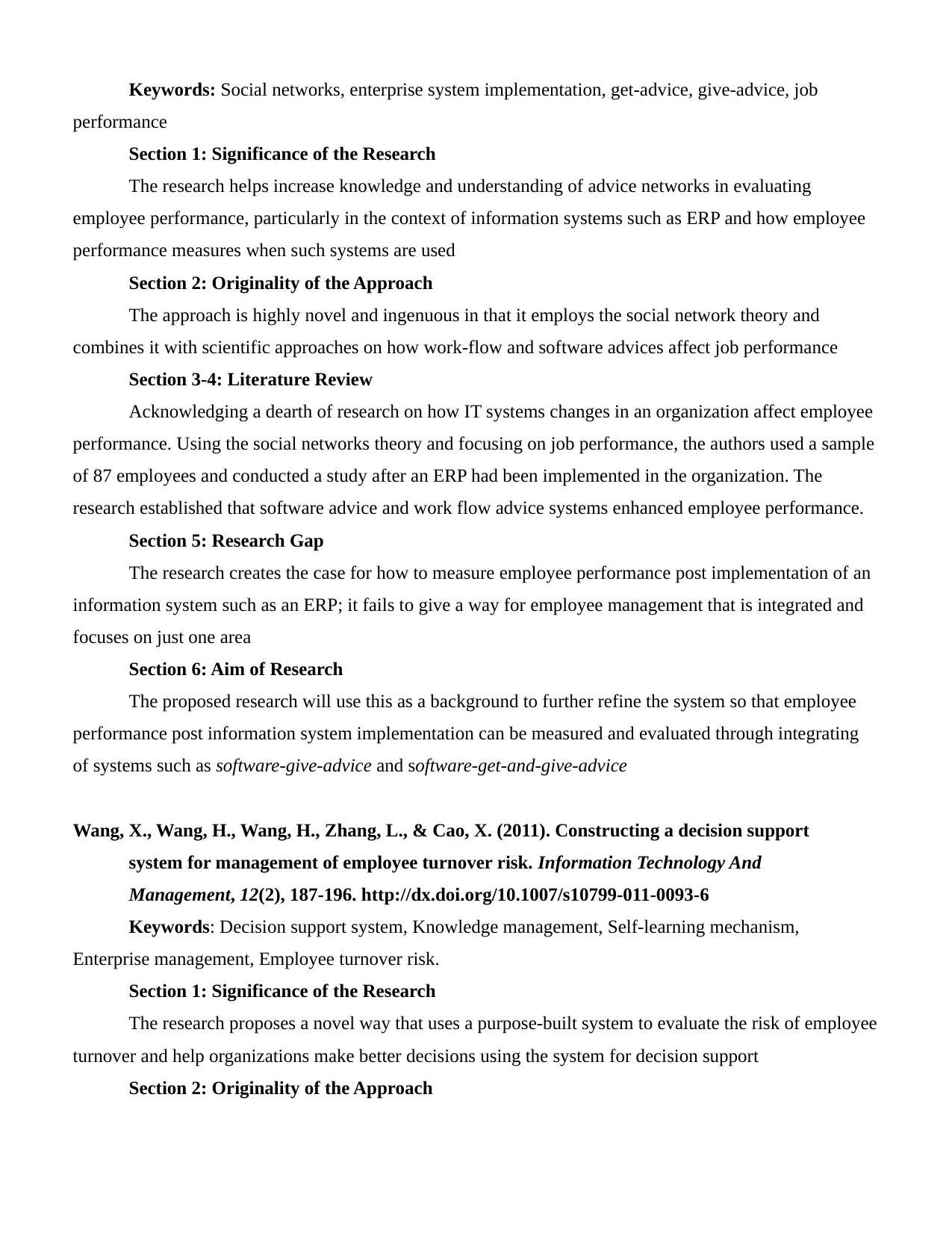
Keywords: Social networks, enterprise system implementation, get-advice, give-advice, job
performance
Section 1: Significance of the Research
The research helps increase knowledge and understanding of advice networks in evaluating
employee performance, particularly in the context of information systems such as ERP and how employee
performance measures when such systems are used
Section 2: Originality of the Approach
The approach is highly novel and ingenuous in that it employs the social network theory and
combines it with scientific approaches on how work-flow and software advices affect job performance
Section 3-4: Literature Review
Acknowledging a dearth of research on how IT systems changes in an organization affect employee
performance. Using the social networks theory and focusing on job performance, the authors used a sample
of 87 employees and conducted a study after an ERP had been implemented in the organization. The
research established that software advice and work flow advice systems enhanced employee performance.
Section 5: Research Gap
The research creates the case for how to measure employee performance post implementation of an
information system such as an ERP; it fails to give a way for employee management that is integrated and
focuses on just one area
Section 6: Aim of Research
The proposed research will use this as a background to further refine the system so that employee
performance post information system implementation can be measured and evaluated through integrating
of systems such as software-give-advice and software-get-and-give-advice
Wang, X., Wang, H., Wang, H., Zhang, L., & Cao, X. (2011). Constructing a decision support
system for management of employee turnover risk. Information Technology And
Management, 12(2), 187-196. http://dx.doi.org/10.1007/s10799-011-0093-6
Keywords: Decision support system, Knowledge management, Self-learning mechanism,
Enterprise management, Employee turnover risk.
Section 1: Significance of the Research
The research proposes a novel way that uses a purpose-built system to evaluate the risk of employee
turnover and help organizations make better decisions using the system for decision support
Section 2: Originality of the Approach
performance
Section 1: Significance of the Research
The research helps increase knowledge and understanding of advice networks in evaluating
employee performance, particularly in the context of information systems such as ERP and how employee
performance measures when such systems are used
Section 2: Originality of the Approach
The approach is highly novel and ingenuous in that it employs the social network theory and
combines it with scientific approaches on how work-flow and software advices affect job performance
Section 3-4: Literature Review
Acknowledging a dearth of research on how IT systems changes in an organization affect employee
performance. Using the social networks theory and focusing on job performance, the authors used a sample
of 87 employees and conducted a study after an ERP had been implemented in the organization. The
research established that software advice and work flow advice systems enhanced employee performance.
Section 5: Research Gap
The research creates the case for how to measure employee performance post implementation of an
information system such as an ERP; it fails to give a way for employee management that is integrated and
focuses on just one area
Section 6: Aim of Research
The proposed research will use this as a background to further refine the system so that employee
performance post information system implementation can be measured and evaluated through integrating
of systems such as software-give-advice and software-get-and-give-advice
Wang, X., Wang, H., Wang, H., Zhang, L., & Cao, X. (2011). Constructing a decision support
system for management of employee turnover risk. Information Technology And
Management, 12(2), 187-196. http://dx.doi.org/10.1007/s10799-011-0093-6
Keywords: Decision support system, Knowledge management, Self-learning mechanism,
Enterprise management, Employee turnover risk.
Section 1: Significance of the Research
The research proposes a novel way that uses a purpose-built system to evaluate the risk of employee
turnover and help organizations make better decisions using the system for decision support
Section 2: Originality of the Approach
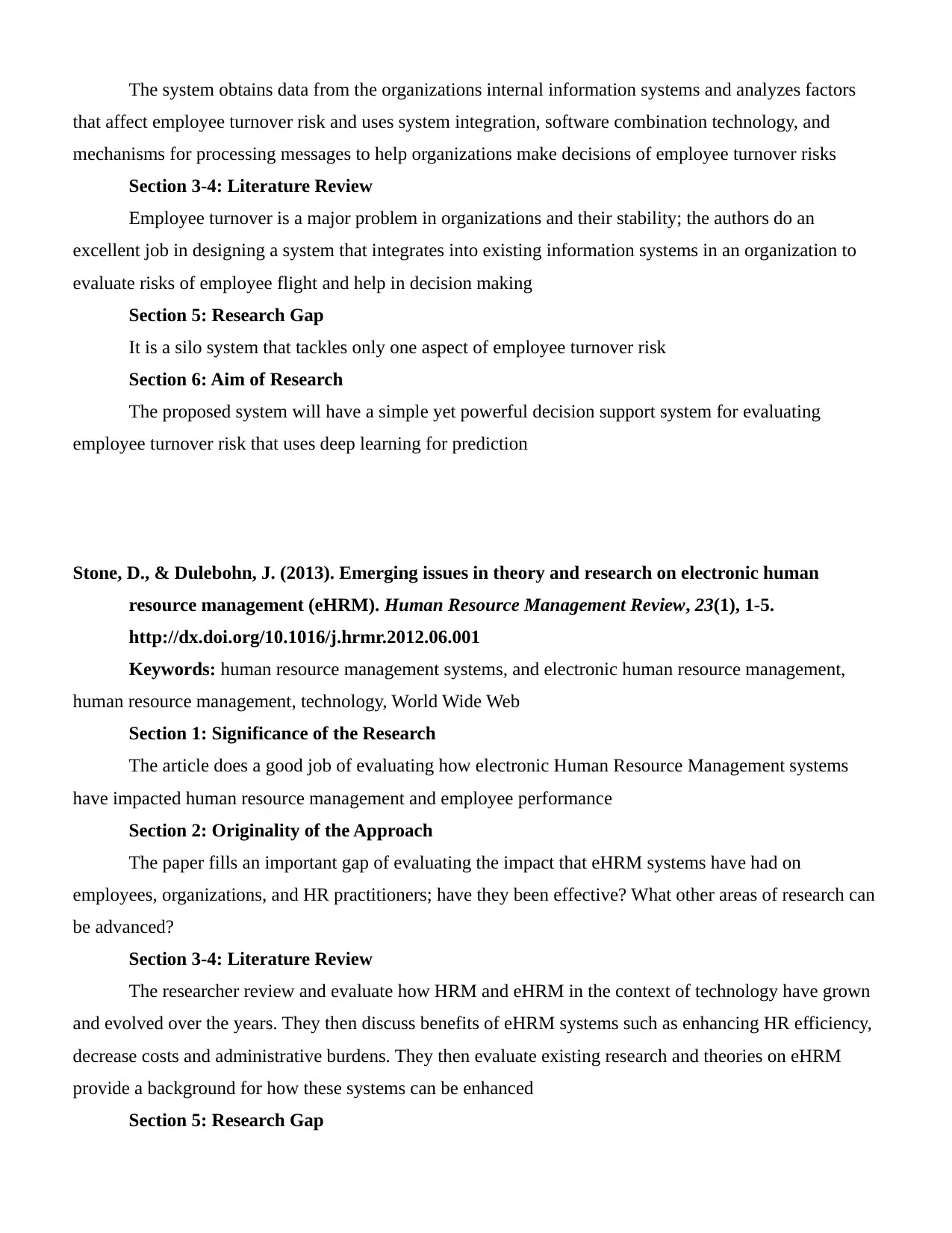
The system obtains data from the organizations internal information systems and analyzes factors
that affect employee turnover risk and uses system integration, software combination technology, and
mechanisms for processing messages to help organizations make decisions of employee turnover risks
Section 3-4: Literature Review
Employee turnover is a major problem in organizations and their stability; the authors do an
excellent job in designing a system that integrates into existing information systems in an organization to
evaluate risks of employee flight and help in decision making
Section 5: Research Gap
It is a silo system that tackles only one aspect of employee turnover risk
Section 6: Aim of Research
The proposed system will have a simple yet powerful decision support system for evaluating
employee turnover risk that uses deep learning for prediction
Stone, D., & Dulebohn, J. (2013). Emerging issues in theory and research on electronic human
resource management (eHRM). Human Resource Management Review, 23(1), 1-5.
http://dx.doi.org/10.1016/j.hrmr.2012.06.001
Keywords: human resource management systems, and electronic human resource management,
human resource management, technology, World Wide Web
Section 1: Significance of the Research
The article does a good job of evaluating how electronic Human Resource Management systems
have impacted human resource management and employee performance
Section 2: Originality of the Approach
The paper fills an important gap of evaluating the impact that eHRM systems have had on
employees, organizations, and HR practitioners; have they been effective? What other areas of research can
be advanced?
Section 3-4: Literature Review
The researcher review and evaluate how HRM and eHRM in the context of technology have grown
and evolved over the years. They then discuss benefits of eHRM systems such as enhancing HR efficiency,
decrease costs and administrative burdens. They then evaluate existing research and theories on eHRM
provide a background for how these systems can be enhanced
Section 5: Research Gap
that affect employee turnover risk and uses system integration, software combination technology, and
mechanisms for processing messages to help organizations make decisions of employee turnover risks
Section 3-4: Literature Review
Employee turnover is a major problem in organizations and their stability; the authors do an
excellent job in designing a system that integrates into existing information systems in an organization to
evaluate risks of employee flight and help in decision making
Section 5: Research Gap
It is a silo system that tackles only one aspect of employee turnover risk
Section 6: Aim of Research
The proposed system will have a simple yet powerful decision support system for evaluating
employee turnover risk that uses deep learning for prediction
Stone, D., & Dulebohn, J. (2013). Emerging issues in theory and research on electronic human
resource management (eHRM). Human Resource Management Review, 23(1), 1-5.
http://dx.doi.org/10.1016/j.hrmr.2012.06.001
Keywords: human resource management systems, and electronic human resource management,
human resource management, technology, World Wide Web
Section 1: Significance of the Research
The article does a good job of evaluating how electronic Human Resource Management systems
have impacted human resource management and employee performance
Section 2: Originality of the Approach
The paper fills an important gap of evaluating the impact that eHRM systems have had on
employees, organizations, and HR practitioners; have they been effective? What other areas of research can
be advanced?
Section 3-4: Literature Review
The researcher review and evaluate how HRM and eHRM in the context of technology have grown
and evolved over the years. They then discuss benefits of eHRM systems such as enhancing HR efficiency,
decrease costs and administrative burdens. They then evaluate existing research and theories on eHRM
provide a background for how these systems can be enhanced
Section 5: Research Gap
⊘ This is a preview!⊘
Do you want full access?
Subscribe today to unlock all pages.

Trusted by 1+ million students worldwide
1 out of 22
Your All-in-One AI-Powered Toolkit for Academic Success.
+13062052269
info@desklib.com
Available 24*7 on WhatsApp / Email
![[object Object]](/_next/static/media/star-bottom.7253800d.svg)
Unlock your academic potential
Copyright © 2020–2025 A2Z Services. All Rights Reserved. Developed and managed by ZUCOL.